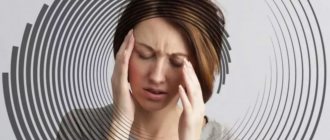Dizziness is the second most common problem with which people turn to neurologists. It occurs only slightly less frequently than headaches. Moreover, the frequency of its occurrence increases proportionally with age, and women suffer from such attacks 2-3 times more often than men. But dizziness refers to quite different symptoms, from the sensation of rotation of surrounding objects or one’s body to darkening of the eyes, unsteadiness of gait, etc. And there are even more reasons for the occurrence of such disorders. One of the most commonplace is an increase or decrease in blood pressure. But if the tonometer readings are within the normal range (120/70) or close to it, you should look for the cause of dizziness elsewhere.
How to determine the cause of dizziness at normal blood pressure
Most often, finding out the cause of a patient’s health problems begins with collecting anamnesis and measuring blood pressure, since in most cases this allows you to immediately eliminate a whole range of disorders. The cause of dizziness without changes in blood pressure can be a rise to altitude, a long trip in a car or boat, or physical fatigue. In such situations, there is usually no threat to health and no need to see a doctor.
In other cases, it is necessary to differentiate systemic dizziness from non-systemic dizziness. In the first case, there is damage to the vestibular analyzer, i.e., the organ responsible for maintaining balance and adequate reactions of the body to changes in the position of the body or head. Non-systemic dizziness is caused by other diseases that are in no way related to the work of the vestibular analyzer.
With normal blood pressure levels and the absence of heart and vascular diseases, systemic (vestibular or true) dizziness is most often diagnosed. According to statistics, about 30% of people encounter it at least once in their lives.
A very important point in determining the cause of a disturbance in well-being is an accurate description of the sensations that arise during an attack. At the same time, it is important to try to avoid the word “dizziness” and talk in as much detail as possible about the feelings that arise.
Systemic vertigo is characterized by the presence of various illusions of movement. This may be a feeling:
- rotation of the body in space or vice versa of environmental objects;
- rocking the bed on which the patient is lying, rocking in a boat, falling into space;
- the ground leaving under your feet, the ceiling collapsing, etc.
With systemic dizziness, which occurs with normal blood pressure, there is no sensation of darkening in the eyes, flickering of spots, fog in the head, lightheadedness, or unsteadiness. Such symptoms indicate the non-systemic nature of the disorder and the need to search for causes in pathologies of other organs, not excluding the heart and blood vessels. After all, during an examination, blood pressure may be normal, but sharply fall or rise in response to a specific trigger.
The main distinguishing feature of systemic vertigo is nystagmus - rapid, involuntary movements of the eyeballs.
Causes of systemic dizziness
Systemic or vestibular vertigo may be central or peripheral. In the first case, the reason lies in damage to the corresponding nuclei of the brain stem and its vestibular centers, disruption of vestibular connections, which is typical for:
- circulatory disorders in the vertebrobasilar system, accompanying a transient ischemic attack or stroke, which is often observed in diseases of the spine and cervical osteochondrosis in particular;
- vestibular migraine;
- multiple sclerosis.
When the central part of the vestibular analyzer is damaged, the severity of symptoms increases smoothly. They are not very pronounced, but can persist for several days or even weeks. In such cases, headaches, visual disturbances, inability to walk and falls are also often observed.
Central vestibular vertigo accounts for 12% of all cases of patients visiting doctors with similar complaints.
In case of peripheral vestibular vertigo, the problem should be sought in damage to the vestibular analyzer or nerve. In such situations, it may consist in the development of:
- benign paroxysmal positional vertigo (BPPV);
- Meniere's disease;
- vestibular neuritis;
- bilateral vestibulopathy;
- neurovascular conflict, etc.
There is a whole range of other peripheral causes of dysfunction of the vestibular analyzer, but they are much less common - less than 0.5% of cases. But almost always, when the vestibular analyzer or nerve is damaged, the attack begins acutely and lasts no more than a day. It is characterized by a sudden onset of a pronounced sensation of rotation. This may be accompanied by nausea and even vomiting, tinnitus and hearing loss.
Causes of non-systemic dizziness
Dizziness while maintaining normal blood pressure levels can be provoked by:
- inflammatory processes of the ear;
- following a strict low-carbohydrate diet;
- Iron-deficiency anemia;
- taking certain medications;
- endocrine disorders, including diabetes mellitus;
- infectious diseases accompanied by a significant increase in body temperature.
But in such situations, patients are usually aware of their problem and the possibility of dizziness. The only exception, perhaps, is iron deficiency anemia, which provokes increased fatigue. But to diagnose it, it is enough to take a general blood test.
When dizziness occurs against the background of normal blood pressure, its psychogenic origin cannot be excluded. This is observed in 15% of cases and therefore deserves special attention.
Cases when you should consult a doctor immediately
You should consult a doctor as soon as possible in cases where dizziness is accompanied by the following symptoms:
- increased body temperature;
- persistent vomiting;
- severe headache, weakness of arm or leg muscles;
- severe dizziness lasts more than an hour;
- during an attack of dizziness the person lost consciousness;
- when dizzy, the patient fell and was seriously injured;
- A patient with diabetes mellitus and hypertension developed severe dizziness.
BPPV
BPPV is diagnosed in 17% of patients complaining of dizziness and is the most common cause of its occurrence. Moreover, the frequency of its occurrence increases in proportion to age, and in women it occurs 2 times more often. This is a disease in which otoliths move into the semicircular canals of the inner ear.
Otoliths are calcium carbonate crystals normally located in the otolithic membrane of the inner ear.
With BPPV, attacks are usually triggered by head movements, especially at night, when the patient cannot control himself. There are frequent situations when dizziness occurs after turning in a dream or getting up/getting out of bed. In this case, dizziness begins acutely, but lasts less than a minute, although it may be accompanied by nausea and vomiting, nystagmus. It is not associated with hearing loss, noise, or ringing in the ears.
The duration of the attack usually does not exceed several minutes.
In most cases, the causes of BPPV cannot be determined. Only in certain situations is its development associated with head injuries, ear surgeries, or previous diseases of the inner ear.
But on the other hand, BPPV does not require specific treatment and, as a rule, goes away on its own in a few weeks or months. Patients are only taught special maneuvers to facilitate the release of particles from the affected semicircular canal to eliminate dizziness. But before they are carried out, it is imperative to consult a doctor who will confirm or deny the presence of BPPV and determine its type. Otherwise, as well as if the technique is violated, your condition may worsen.
There are more than 5 different maneuvers to relieve an attack of dizziness due to BPPV. The choice of which one will be most effective for an individual patient depends on which part of the labyrinthitis his otoliths move to. In most cases, the Eple maneuver is recommended. Its essence is as follows:
- turn the head 45° towards the affected ear and lie on your back (this may be accompanied by increased dizziness);
- the head is turned sharply towards the healthy ear so that it is at an angle of 45°;
- continue turning to the healthy side with the whole body so that at the end point the face is directed downward;
- rise to a sitting position, maintaining a head tilt of 45°.
You should remain in each position for about 1 minute, and change them as abruptly as possible.
In half of the cases, correct implementation of therapeutic maneuvers allows for long-term elimination of BPPV symptoms. Although 25-50% of patients experience relapses. In such situations, repeated maneuvers are indicated.
Meniere's disease
According to statistics, Meniere's disease is diagnosed in 10% of patients who complain of dizziness. This is a disease of the inner ear, in which there is an increase in the volume of labyrinthine fluid and an increase in pressure within the labyrinthitis. Most often it occurs after 30 years.
Meniere's disease is characterized by episodes of systemic dizziness, which is associated with a progressive decrease in hearing acuity, tinnitus, and unsteady gait. Often there is also a feeling of stuffiness in the ear. In this case, hearing impairment manifests itself to a greater extent directly during an attack of dizziness, which can last from several minutes to a couple of hours. This is associated with nausea and vomiting.
A characteristic feature of Meniere's disease is the possibility of a so-called aura immediately before an attack. It may manifest itself:
- increasing noise in the affected ear;
- ear congestion;
- hearing impairment.
But the aura is not observed in all cases. Therefore, in its absence, the possibility of dizziness at normal pressure due to Meniere’s disease cannot be excluded.
When the pathology manifests itself, attacks occur frequently and initially their frequency increases. Over time, the trend reverses and dizziness bothers patients less and less.
During the disease there are 3 stages:
- Stage 1 – tinnitus is observed only periodically and is accompanied by a feeling of fullness and congestion, which leads to a decrease in hearing acuity. But at this stage, hearing between attacks is restored.
- Stage 2 – noise and congestion in the ears are constantly present, attacks become more frequent and occur almost daily. In this case, the dizziness is very intense, and hearing between attacks is practically not restored and can completely disappear.
- Stage 3 – the interval between attacks gradually increases, although hearing loss persists and is irreversible. There is also a constant feeling of unsteadiness and instability.
Initially, with Meniere's disease, only one ear is affected, but in 50% of patients, within several years, the second ear is also involved in the pathological process.
When diagnosing Meniere's disease, the main priority of treatment is to prevent the occurrence of attacks, since suddenly appearing intense dizziness significantly reduces the patient's quality of life, and in the early stages can deprive him of his ability to work due to the high frequency of episodes. For this purpose, patients are prescribed a salt-restricted diet, as well as individually selected drug therapy.
Treatment methods
The patient must understand that dizziness is not an independent disease, but only a symptom of a particular pathology.
In order to get rid of it, it is necessary to influence the root cause of the violation:
- BPPV may require surgery to remove the otoliths from the inner ear. However, if they do not block his passages, then you can take a wait-and-see approach. Sometimes the disorder goes away on its own.
- For infections of the inner ear, the patient may be prescribed antibiotics to fight bacteria, corticosteroids to eliminate inflammation, and Diazepam to reduce the pathological activity of the central nervous system.
- For Meniere's disease, treatment should be aimed at eliminating pathological symptoms; the person is prescribed antiemetics or benzodiazepines. Patients receive diuretics on an ongoing basis.
- For migraines, the patient is prescribed antidepressants, anticonvulsants, and beta blockers. Analgesics and antihistamines can be used to relieve an attack.
- If a patient has anemia, then he needs to start eating right, enrich his menu with meat dishes, eggs, cottage cheese, fresh vegetables and fruits. It is possible to take iron supplements and B vitamins. In severe cases, the patient is advised to receive a transfusion of red blood cells.
- If low blood sugar leads to dizziness, then the patient needs to eat something sweet as quickly as possible. In severe cases, hospitalization is indicated. In the future, the patient will need to carefully monitor blood glucose levels.
Pathological conditions do not always lead to dizziness. To help yourself cope with an attack that was associated with emotional or physical fatigue, you first need to lie down. Before doing this, open the windows to allow fresh air into the room. You can apply a towel soaked in cool water to your forehead.
Be sure to measure your body temperature. If an attack of dizziness does not go away after 20-30 minutes, and a person’s condition worsens, then he needs to call an ambulance.
Video: Dr. Evdokimenko on methods of treating dizziness:
Vestibular neuronitis
Vestibular neuronitis or neuritis means inflammation of the vestibular root of the 8th pair of cranial nerves, i.e., the vestibular-cochlear nerve. It has not yet been reliably determined what exactly provokes the development of this disease. According to research, it is assumed that herpes virus infection type 1 is involved in this. This theory is also supported by the fact that most often neuritis manifests itself after suffering from an acute respiratory infection.
The disease is characterized by a sudden onset of severe dizziness with a sensation of rotation of surrounding objects, which tends to gradually weaken over time. But head movements or changes in body position provoke a deterioration in health. The attack is accompanied by nausea, vomiting, and nystagmus. In this case, the oscillatory movements of the eyes are directed towards the healthy ear. There is also an imbalance, with falls more often occurring on the side of the healthy ear. But vestibular neuritis is not accompanied by hearing impairment or neurological disorders.
Dizziness may last for hours or days, and unsteadiness may persist for a week or longer.
When diagnosing vestibular neuronitis, symptomatic therapy is indicated to alleviate the patient’s well-being. It is designed to eliminate nausea, vomiting and reduce the severity of dizziness. Specific drugs are selected by a neurologist individually, taking into account the characteristics of the patient’s condition and the nature of concomitant diseases. As a rule, the course lasts no more than 3 days.
It is also recommended to perform special visual exercises, head movements, walking and balance exercises. They need to be performed daily, devoting at least half an hour to exercise.
In most cases, the measures taken are sufficient to eliminate the disease and normalize the patient’s condition. Within a few weeks, central vestibular compensation occurs, which leads to the elimination of the symptoms of neuritis. But instability and difficulty maintaining balance, especially when moving the head, can persist for a long time. But in 15% of patients, after the symptoms of vestibular neuronitis subside, the development of BPPV is observed, and psychogenic dizziness often occurs.
Symptoms other than dizziness
As can be seen from the above, the term “dizziness” has a rather narrow medical interpretation (a false sensation of rotation of surrounding objects or one’s own rotation). But, despite this, people also use this term to refer to other symptoms that are not actually dizziness. So, most often “dizziness” is called such phenomena as:
- darkening in the eyes after abruptly rising to your feet from a sitting or lying position;
- a veil before the eyes;
- feeling of imminent loss of consciousness (fainting);
- weakness, nausea, feeling of confusion and unsteadiness in the legs;
- feeling of unsteady gait and impaired balance.
When a person suffering from dizziness comes to see a doctor, he should describe his condition, how he is feeling and the symptoms he is experiencing as accurately as possible, and not simply say that he suffers from “vertigo.” The further examination and treatment plan will depend on the accuracy of the description of the existing symptoms.
In contrast to true dizziness, which appears due to a disruption in the functioning of a person’s balance system, false dizziness, which patients describe as a feeling of weakness, instability, darkening in the eyes, blurred vision, etc., can most often be a sign of anemia, chronic fatigue , hypovitaminosis, hypotension and vegetative-vascular dystonia. In addition, fainting, episodes of lipothymia (a sharp decrease in muscle tone with great physical stress) and short-term attacks of epilepsy can also be confused with dizziness.
We pay special attention to attacks of sudden dizziness and weakness in people who have diabetes. In this category of patients, dizziness and weakness may indicate a dangerous decrease in blood glucose levels.
Bilateral vestibulopathy
Bilateral vestibulopathy refers to bilateral deficits in vestibular function, which is clinically manifested by:
- attacks of dizziness while moving with the illusion of rotation of the environment;
- instability;
- imbalances, especially severe in the dark and when walking on uneven surfaces;
- decreased visual acuity while walking and making head movements.
But all the symptoms are observed only when the person is in an upright position. If he sits or lies, there are no such violations.
Most often, bilateral vestibulopathy occurs as a result of taking medications, especially aminoglycoside antibiotics, as well as after suffering from infectious and inflammatory diseases of the brain and some other pathologies.
It is impossible to completely eliminate the disorder, but by performing a special set of exercises selected separately for each patient, it is possible to achieve the development of central vestibular compensation.
Diagnostics
To find out the cause of dizziness, you need to see a therapist. The general practitioner will examine and interview the patient and outline an examination plan for him. If necessary, the patient will be referred to specialized specialists, such as a neurologist, otolaryngologist, endocrinologist, etc. If a stroke or cancer is suspected, the patient is urgently prescribed a CT or MRI of the brain.
The planned examination scheme includes:
- Donating blood for general and biochemical analysis.
- Donating blood to determine blood sugar levels.
- ECG of the heart.
The neurologist will conduct a series of tests with the patient aimed at assessing the functioning of the vestibular apparatus, and may prescribe an ultrasound scan of the vessels of the neck and brain. An otolaryngologist will evaluate the condition of the inner ear.
During the appointment, the patient must inform the doctor about what medications he is taking.
After a comprehensive examination, it will be possible to make the most accurate diagnosis and prescribe treatment.
Neurovascular conflict
In neurovascular conflict, episodes of dizziness are caused by compression of the 8th pair of cranial nerves by an abnormally located blood vessel. As a result, the myelin sheath of the nerve becomes thinner, which leads to its constant stimulation by the vessel and overexcitation of the vestibular nucleus.
This is accompanied by short attacks of dizziness, which usually occur with a certain position of the head. This is often associated with tinnitus and hearing loss. In this case, episodes of dizziness can bother the patient several times a year, or 2-3 times a day.
For frequent, severe attacks, patients are prescribed specific drug treatment. If in response to it there is a decrease in the number of attacks, a decrease in their severity and duration, this serves as additional confirmation of the presence of a neurovascular conflict. In such situations, MRI is highly recommended. If its results confirm the diagnosis, it is worth performing surgery to decompress the vestibular-cochlear nerve as early as possible before hyperactivity of the vestibular nucleus develops.
Dizziness and weakness
Dizziness and weakness can occur in many cases. This condition does not always mean that you are sick. Thus, in adolescence, weakness and dizziness are explained by hormonal changes. The autonomic nervous system is being rebuilt and growth rates are accelerating. Against this background, weakness, dizziness and even fainting are possible. Also, dizziness and weakness are typical during pregnancy.
If the cases mentioned do not apply to you, dizziness and accompanying weakness most likely indicate some kind of pathology. Weakness and dizziness are most often observed with:
- anemia (low hemoglobin content in the blood);
- cerebrovascular accident. In this case, tinnitus, decreased attention, and the appearance of black spots before the eyes may also occur;
- a sharp increase in blood pressure (hypertensive crisis). In this case, dizziness and weakness may be accompanied by a headache;
- neurocirculatory dystonia;
- oncological diseases.
Vestibular migraine
Migraine is a widespread disease, the manifestations of which are very diverse. Most often, in addition to dizziness at normal blood pressure, migraine is accompanied by a severe headache. As a rule, it is one-sided, pulsating and can persist for several minutes, hours, or several days. Often during an attack there is increased sensitivity to light and sounds.
Some patients notice the appearance of an aura before the onset of a migraine. In most cases, it consists of the occurrence of visual disturbances: loss of visual fields, flickering of spots in front of the eyes, luminous lines, etc. The aura usually appears an hour or less before the onset of the attack, and then disappears without a trace.
Migraines are more often diagnosed in women, and episodes of dizziness may be directly related to the phase of the menstrual cycle.
Treatment is carried out with medication. Usually, to eliminate pain and dizziness, the same medications are prescribed as for classic migraine. If attacks occur frequently, basic therapy is selected that is appropriate to the situation. All patients are also advised to avoid stress, eat right, normalize their work and rest schedule, and regulate the amount of physical activity.








